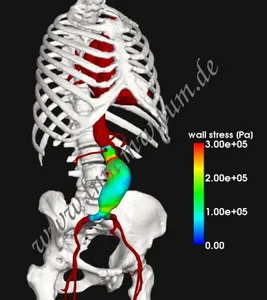Rupture Risk Prediction for Abdominal Aortic Aneurysms
Andreas Maier, Sebastian Kehl, Jonas Biehler, Susanna Tinkl
Joint project with the Clinic for Vascular Surgery at the university hospital Klinikum rechts der Isar.
Funding is provided by the "Deutsche Forschungsgemeinschaft" (project GE 2254/1-1: "Individualisierte Rupturrisikostratifizierung und Analyse mechanobiologischer Interaktionen beim abdominalen Aortenaneurysma (AAA)")
Includes IGSSE-project 3-07.
Abdominal aortic aneurysm rupture ranks among the most common causes of death in western countries. In Germany 1 to 3% of deaths of men over 65 are caused by this incident. If left untreated about 25% of all abdominal aortic aneurysms rupture which in most cases causes death. However surgical aneurysm repair procedures also carry significant mortality risks. Thus clinicians are faced with the decision weather the risk of repair is justified by the risk of aneurysm rupture. Currently this decision is taken with respect to a "maximum diameter criterion", which suggests surgery if the maximum diameter of the aneurysm exceeds 5.5cm.

This project aims at the development of more individual criteria to asses the patient specific risk of aneurysm rupture. Rupture is a mechanical incident as it takes place when the stress exceeds the strength of the aortic wall. Consequently, the combination of clinical experience with mechanical consideration is the way to follow for a more reliable patient-specific rupture risk prediction. Research thereby focuses on measuring and understanding the change of mechanical properties of arterial wall during aneurysm growth and to identify dangerous conditions before deadly rupture occurs.
The following techniques are used:
- Finite Element simulations and Fluid-Structure Interaction simulations of patient-specific aneurysms
- Modern medical imaging technologies: Positron Emission Tomography / Computed Tomograpy (PET/CT)
- Mechanical tensile testing of aneurysm wall samples
Interested students, please see:
- Biomechanik
- Computational Bioengineering - From Imaging to Simulation